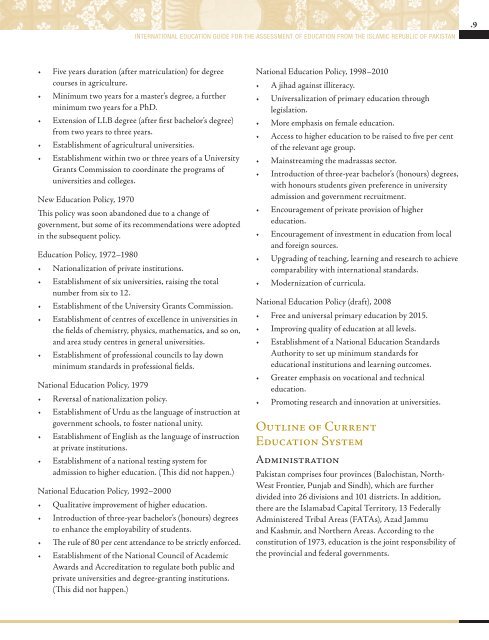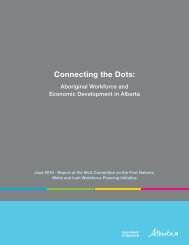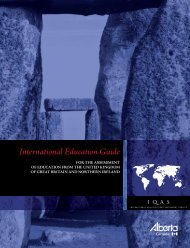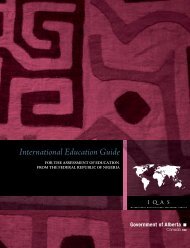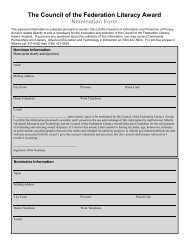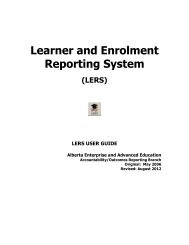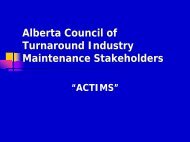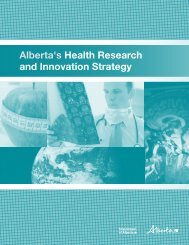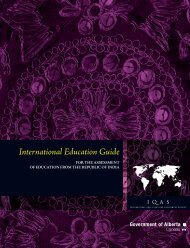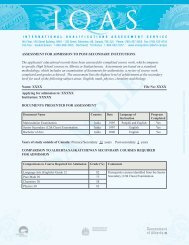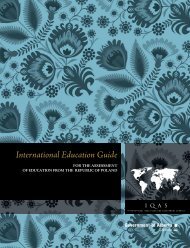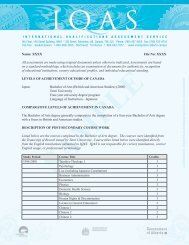International Education Guide - Enterprise and Advanced Education ...
International Education Guide - Enterprise and Advanced Education ...
International Education Guide - Enterprise and Advanced Education ...
Create successful ePaper yourself
Turn your PDF publications into a flip-book with our unique Google optimized e-Paper software.
INTERNATIONAL EDUCATION GUIDE for the assessment of education from the Islamic Republic of Pakistan<br />
.9<br />
• Five years duration (after matriculation) for degree<br />
courses in agriculture.<br />
• Minimum two years for a master’s degree, a further<br />
minimum two years for a PhD.<br />
• Extension of LLB degree (after first bachelor’s degree)<br />
from two years to three years.<br />
• Establishment of agricultural universities.<br />
• Establishment within two or three years of a University<br />
Grants Commission to coordinate the programs of<br />
universities <strong>and</strong> colleges.<br />
New <strong>Education</strong> Policy, 1970<br />
This policy was soon ab<strong>and</strong>oned due to a change of<br />
government, but some of its recommendations were adopted<br />
in the subsequent policy.<br />
<strong>Education</strong> Policy, 1972–1980<br />
• Nationalization of private institutions.<br />
• Establishment of six universities, raising the total<br />
number from six to 12.<br />
• Establishment of the University Grants Commission.<br />
• Establishment of centres of excellence in universities in<br />
the fields of chemistry, physics, mathematics, <strong>and</strong> so on,<br />
<strong>and</strong> area study centres in general universities.<br />
• Establishment of professional councils to lay down<br />
minimum st<strong>and</strong>ards in professional fields.<br />
National <strong>Education</strong> Policy, 1979<br />
• Reversal of nationalization policy.<br />
• Establishment of Urdu as the language of instruction at<br />
government schools, to foster national unity.<br />
• Establishment of English as the language of instruction<br />
at private institutions.<br />
• Establishment of a national testing system for<br />
admission to higher education. (This did not happen.)<br />
National <strong>Education</strong> Policy, 1992–2000<br />
• Qualitative improvement of higher education.<br />
• Introduction of three-year bachelor’s (honours) degrees<br />
to enhance the employability of students.<br />
• The rule of 80 per cent attendance to be strictly enforced.<br />
• Establishment of the National Council of Academic<br />
Awards <strong>and</strong> Accreditation to regulate both public <strong>and</strong><br />
private universities <strong>and</strong> degree-granting institutions.<br />
(This did not happen.)<br />
National <strong>Education</strong> Policy, 1998–2010<br />
• A jihad against illiteracy.<br />
• Universalization of primary education through<br />
legislation.<br />
• More emphasis on female education.<br />
• Access to higher education to be raised to five per cent<br />
of the relevant age group.<br />
• Mainstreaming the madrassas sector.<br />
• Introduction of three-year bachelor’s (honours) degrees,<br />
with honours students given preference in university<br />
admission <strong>and</strong> government recruitment.<br />
• Encouragement of private provision of higher<br />
education.<br />
• Encouragement of investment in education from local<br />
<strong>and</strong> foreign sources.<br />
• Upgrading of teaching, learning <strong>and</strong> research to achieve<br />
comparability with international st<strong>and</strong>ards.<br />
• Modernization of curricula.<br />
National <strong>Education</strong> Policy (draft), 2008<br />
• Free <strong>and</strong> universal primary education by 2015.<br />
• Improving quality of education at all levels.<br />
• Establishment of a National <strong>Education</strong> St<strong>and</strong>ards<br />
Authority to set up minimum st<strong>and</strong>ards for<br />
educational institutions <strong>and</strong> learning outcomes.<br />
• Greater emphasis on vocational <strong>and</strong> technical<br />
education.<br />
• Promoting research <strong>and</strong> innovation at universities.<br />
Outline of Current<br />
<strong>Education</strong> System<br />
Administration<br />
Pakistan comprises four provinces (Balochistan, North-<br />
West Frontier, Punjab <strong>and</strong> Sindh), which are further<br />
divided into 26 divisions <strong>and</strong> 101 districts. In addition,<br />
there are the Islamabad Capital Territory, 13 Federally<br />
Administered Tribal Areas (FATAs), Azad Jammu<br />
<strong>and</strong> Kashmir, <strong>and</strong> Northern Areas. According to the<br />
constitution of 1973, education is the joint responsibility of<br />
the provincial <strong>and</strong> federal governments.


